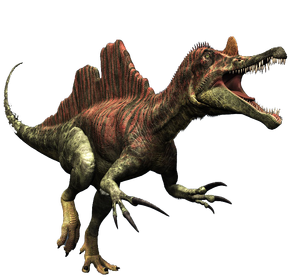
Ichthyovenator is a spinosaurid theropod dinosaur from the Early Cretaceous of Laos.
Discovery and naming[]
Ichthyovenator is known from a single type species, Ichthyovenator laosensis. The species was named and described in 2012 by Ronan Allain, Tiengkham Xeisanavong, Philippe Richir and Bounsou Khentavong. The generic name is derived from Greek ἰχθύς (ichthys), "fish", and Latin venator, "hunter", in reference to a piscivorous lifestyle. The specific name refers to the provenance from Laos.
Ichthyovenator is represented by a single holotype or syntype series MDS BK10-01 — 15. The fossil was found in 2010 in the Grès supérieurs Formation of the Savannakhet Basin in Savannakhet Province, in a layer which is likely Aptian in age. It consists of a partial skeleton lacking the skull. It includes the penultimate dorsal vertebra, the spine of the last dorsal vertebra, five sacral vertebrae, the first two caudal vertebrae, both ilia, both ischia, a right pubis and a posterior rib. The bones were recovered from a surface area of less than two square metres. At the time of the description, excavations at the site were still on-going.
Description[]
The describers determined some unique derived traits, autapomorphies, of Ichthyovenator. There is a sinusoid sail present on the back and the hip. The spine of the penultimate dorsal vertebra has 410% of the height of the vertebral centrum. Its front upper edge features a finger-like process. The spines of the third and fourth sacral vertebrae are fan-shaped. The lateral processes of the first tail vertebra, when seen from above, have a sinusoid profile. The sides of first tail vertebra are deeply hollowed out between the prezygapophyses and the diapophyses. The ilium is longer compared to the pubic bone than with any other known theropod. Some additional traits are unique within the Tetanurae. The ribs of the last back vertebrae articulate with the complex of the breast bone. On the hind rim of the pubic bone, two openings, the foramen obturatum and a lower fenestra, are not fully closed, making them into notches. The main body of the ischium is large with an opening in its side. The shaft of the ischium is flattened sideways.
Unlike other spinosaurids, Ichthyovenator has at least two separate sails. The preserved axial column, over a metre long, shows a very high spine on the penultimate, twelfth, back vertebra, representing a crest extending from the back, and a lower rounded sail extending from the sacral vertebrae of the hip, with its highest point above the third and fourth sacrals. The 546 millimetre long spine of the twelfth dorsal vertebra widens towards the top, giving it a trapezoidal shape, whereas the spines of other spinosaurids are roughly rectangular. Its front corner forms a three centimetre long narrow process, pointing upwards. The spine of the thirteenth dorsal vertebra has only been partly preserved, its upper and lower ends having broken off. From its general shape the describers inferred however, that it was about as long as the preceding spine. This would imply that the back edge of the front sail would form a rectangular corner, as the spine of the first sacral vertebra is with about twenty-one centimetres much lower, creating a sudden hiatus. The spine of the second sacral vertebra steeply curves upwards again, joining the forty-eight centimetres high broad fan-shaped spines of the third and fourth sacrals. The spine of the fifth sacral gradually descends. The sacral spines are not fused, nor have any extensive contacts.
Phylogeny[]
Ichthyovenator was by its describers assigned to the Spinosauridae and more precisely to the Baryonychinae, in a basal position, as the sister species of a [[Clade] formed by Baryonyx and Suchomimus.
Below is a cladogram from Allain et al. (2012):
Template:Clade
